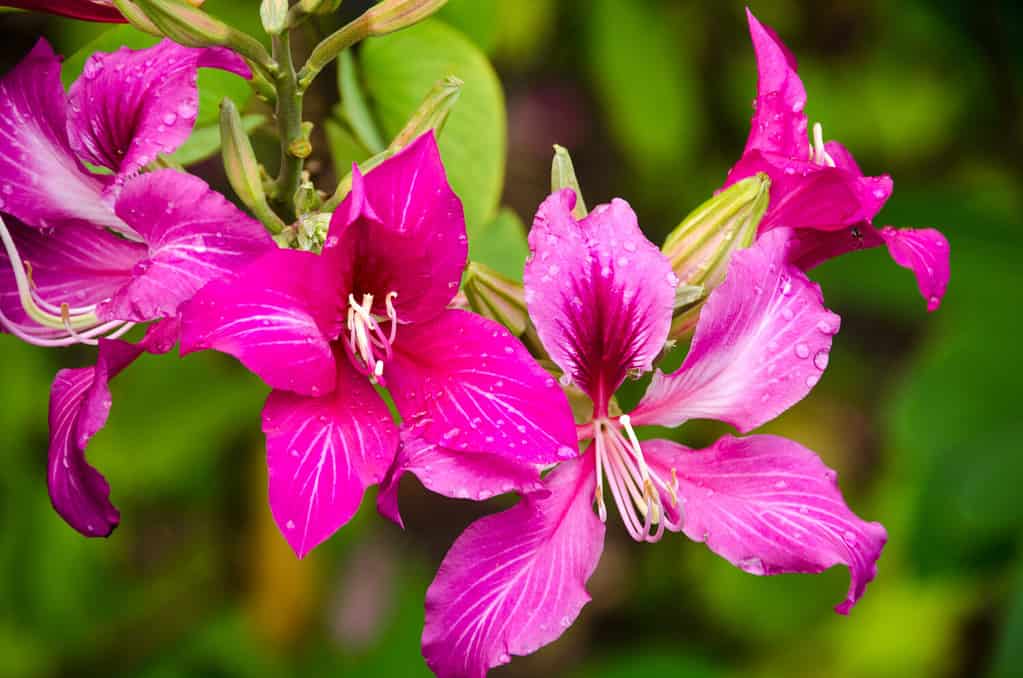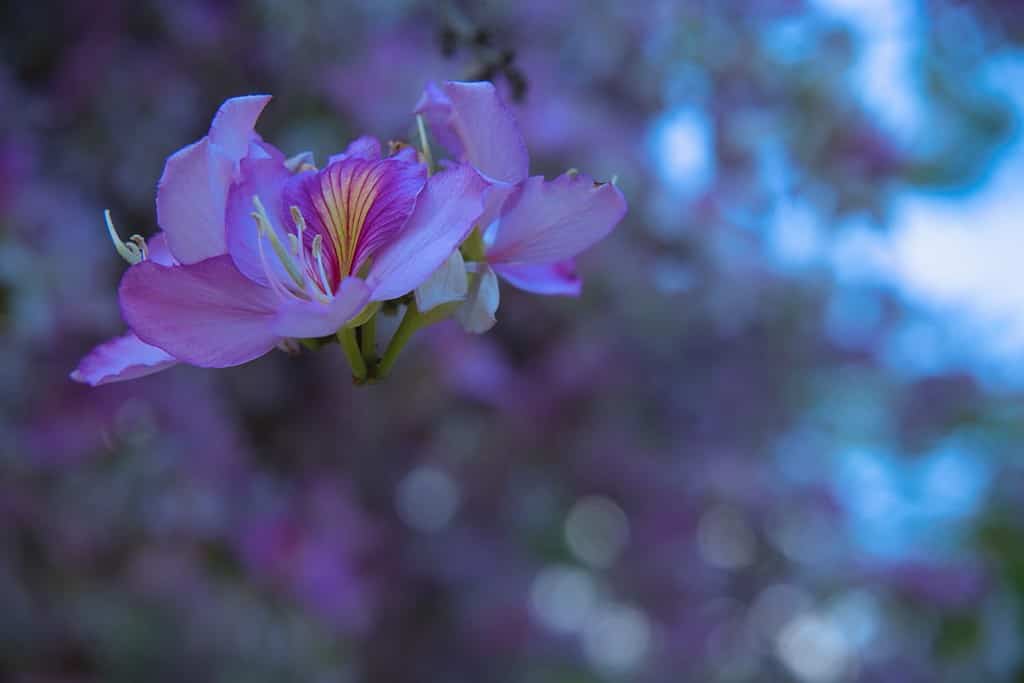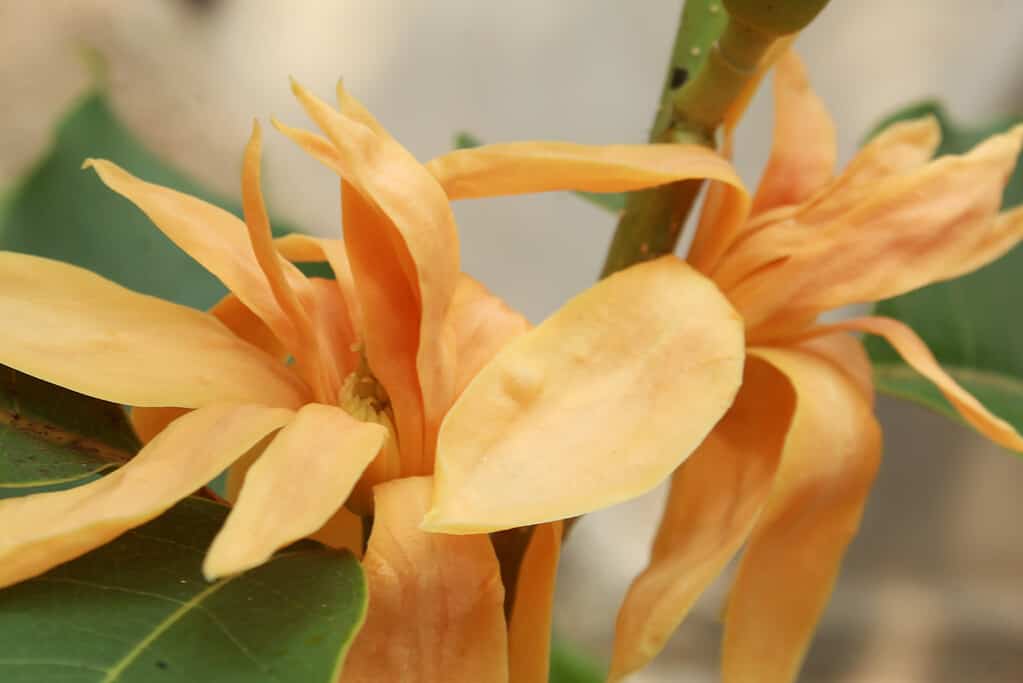Orchids are a diverse group of plants, and their blooming times can vary considerably from species to species. The conditions that the flowers are in also affect when they bloom. Flowers that aren’t in optimal conditions may not reach blooming time as quickly as others.
Most orchids have a natural blooming season that coincides with their native habitat, which isn’t always where they are being grown.
Introduction: Exploring the Blooming Season of Orchids and Its Beauty

While many people grow “orchids,” this actually encompasses many different species. Orchids are wide and diverse.
©Brian Woolman/Shutterstock.com
Orchids are gorgeous flowers. The allure of these flowers lies in their interesting shapes and vibrant colors. You can plant several orchid species and have a pretty diverse set of flowers.
The timing of an orchid’s blooms relies on several different factors, including their biology, environmental factors, and human care. We’ll explore these factors below, too, so you’ll understand exactly when you can expect your flower to bloom.
Different species have different timing, too. We’ll look at some of the more well-known orchid varieties, like the Phalaenopsis, Cymbidium, Dendrobium, and many others. Understanding the difference between these species is absolutely necessary. Some orchids may bloom during the summer, but others may be in full bloom in the winter.
Peak Blooming Seasons: Discovering the Optimal Times for Orchid Blooms in Different Hardiness Zones

The blooms are the main benefit of owning orchids, but where you’re located will affect when they bloom considerably.
©konjaunt/Shutterstock.com
Orchids have a peak blooming season that depends on the hardiness zone and the flower’s species. A flower may react differently in a warmer area than a colder area, and the zones represent this. It’s important to find out your zone and base your flower’s care on that.
The United States Department of Agriculture features a hardiness zone map. We recommend checking this out so that you know what to expect in your specific area. Each zone represents a different climate, which affects how the plants there grow.
Zone 10 and Above
In tropical and subtropical areas, flowers get constant warmth throughout the year. Therefore, they may bloom year-round. In these areas, trying to get orchids to grow isn’t the issue. It’s preventing them from becoming overbearing.
Zone 8 and 9
In this relatively mild zone, some orchid species thrive, like the Cymbidiums. They typically bloom in the late winter or early spring. The cooler temperatures stimulate bud formation, resulting in rare blooms during these cooler months.
Zones 6 and 7
To grow orchids in these areas, you’ll need to rely on a greenhouse or indoor cultivation. These create the necessary conditions for blooming. Orchids like Phalaenopsis can be encouraged to bloom during the late winter in these areas.
Zone 4 and 5
Here, the challenges of growing orchids are pretty difficult. These zones require intensive care and controlled environments. You can’t just grow orchids outside. You’ll have to initiate a period of cool temperature to initiate flowering. Dendrobium orchids and similar species can be coaxed into blooming during the spring or early summer.
Factors Influencing Bloom Time: Examining Environmental and Climatic Factors Affecting Orchid Blooming

If you grow your orchids indoors, you have more control over their environment, which helps you control when your flowers bloom.
©Ruth Laguna/Shutterstock.com
There are tons of factors that can affect when orchids bloom. These flowers have evolved in response to their cues in their native habitats. When you grow them elsewhere, there are tons of things to consider.
- Light: Light plays a huge role in when orchids bloom. Orchids often need a specific amount of light to trigger flowering. Many species, like Phalaenopsis, require bright but indirect light, while others, such as Vanda orchids, thrive in full sun. In most cases, orchids often bloom when days are shorter or when the light levels start to increase.
- Temperature: As you’d probably guess, orchids are affected by temperature. Many orchids, like Cymbidiums, require a period of cooler temperatures to initiate budding and flowering. That said, many tropical species require consistent warmth, making them a good option to grow indoors.
- Humidity: Orchids require a range of different humidity levels. You should try to mimic their natural environment, though this can vary depending on the exact species.
- Seasonal Changes: Orchids respond to seasonal changes. In many cases, these changes are required to encourage blooming. Winter’s cooler temperatures or spring’s warmth may trigger blooming in many different varieties.
- Watering and Fertilization: You must ensure that your orchids receive the proper amount of water and fertilizer. Over- or under-watering these flowers can result in serious problems – sometimes preventing the flowers from blooming at all.
- Potting Media and Containers: The pot and dirt the flower is grown in will affect root health, therefore impacting blooming indirectly. Orchids prefer well-draining media, as it allows air to reach their roots.
- Hormonal Triggers: Hormonal factors can stimulate when certain flower species grow. Ethylene gas, for instance, can act as a hormone to initiate flowering in some orchids. Of course, there isn’t much you can do about this factor.
- Genetic Factors: Each specific species has genetic factors influencing its blooming pattern. Some species are particularly bred to bloom at particular times, for instance.
Some of these factors you can affect, like the amount of fertilizer your flowers get. However, some flowers are simply made to bloom at certain times, and that’s how it is.
Extending Bloom Time: Tips and Techniques to Prolong and Enjoy Orchid Blooms in Your Garden

Once flowers are spent, you should remove them to encourage new flowers to bloom.
©MANORANJAN MISHRA/iStock via Getty Images
Orchid blooms are absolutely magical. However, they only last for a short time. There are some ways to encourage blooming and extend the blooms you do have, though.
- Variety. Start by choosing many types of orchids so that you have some blooms most of the time. As we’ve stated, some orchid species are made to bloom at certain times of the year. Choose orchid species that have staggered blooming schedules to ensure you have blooms going throughout the year.
- Controlled Environments. In regions with harsher weather, you should grow your orchids indoors. Controlling the temperature, humidity, and light helps create conditions for continuous blooms.
- Fertilizer. Most orchids will require fertilizer. Without it, they won’t be able to produce blooms. Therefore, you should aim to provide your orchid with consistent fertilization that matches their needs.
- Repotting. Repot your orchids as they outgrow their containers. Of course, this helps keep them healthy, which encourages blooming. Repotting often provides an opportunity to divide the plant, potentially leading to more flowers.
- Pruning. Remove dead flower spikes and leaves as necessary. This process helps redirect the plant’s energy and opens room for new flowers.
- Light Management. Ensure that your orchids get the right amount of light. Different species require a different amount of light for grooming. Be sure to research your particular species and adjust the amount of light as necessary.
- Temperature Control. Some orchids require a period of cooler weather before they will bloom. In this case, you need to provide the appropriate temperature drop.
- Humidity. Orchids also need proper humidity levels, which vary depending on the particular species. You may need a humidifier to raise the temperature near the orchids.
- Water Carefully. Over-watering or under-watering can stress orchids and affect their blooming. Water orchids thoroughly, but allow the growing medium to dry slightly between waterings.
- Prevent Pests and Diseases. Healthy orchids are more likely to bloom than unhealthy orchids. Look for pests and diseases regularly and address these issues are quickly as possible.
- Produce More Orchids. You can also practice propagation techniques, like dividing orchids, to produce new plants. As you might expect, more plants often equals more blooms.
Use these strategies to help improve the blooms in your garden. Assuming that your plants are healthy, one of the best options may be to just purchase new flowers. After all, more plants typically produce more flowers!
Ready to discover the top 10 cutest dog breeds in the entire world?
How about the fastest dogs, the largest dogs and those that are -- quite frankly -- just the kindest dogs on the planet? Each day, AZ Animals sends out lists just like this to our thousands of email subscribers. And the best part? It's FREE. Join today by entering your email below.
Thank you for reading! Have some feedback for us? Contact the AZ Animals editorial team.








